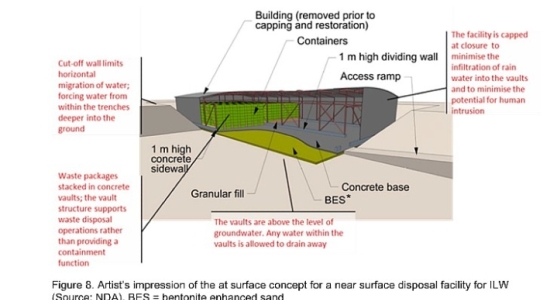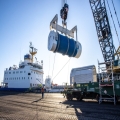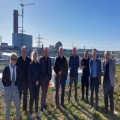In its updated strategy for handling nuclear waste and radioactive substances, the UK proposes to use a shallower disposal facility for suitable intermediate-level waste which was previously earmarked for the planned deep geological disposal facility.
The Department for Energy Security and Net Zero said that the search for a site for a geological disposal facility (GDF) was currently under way in England and Wales, and it was unlikely to be ready to start accepting waste until 2050. The plan has been for it to provide permanent safe disposal of high and intermediate-level waste. The existing near surface disposal facilities are used solely for the disposal of suitable low-level waste.
But following a consultation held last year, the department has now published its response and updated strategy which includes the proposed near surface disposal facility for intermediate-level waste (ILW). It would have the advantages of being ready within 10 years and would allow for quicker decommissioning and savings of around GBP500 million (USD636 million) in storage costs, the department says.
In Managing Radioactive Substances and Nuclear Decommissioning: UK policy framework it says: "A near surface disposal facility for ILW is a facility that can be located at or below the surface (up to 200 metres, the minimum depth of a GDF), and may make use of existing structures. It differs from a GDF in the degree of isolation provided by the facility, including host geology, depth and design.
"A near surface disposal facility for ILW below the surface could be constructed as silos, vaults or caverns and could be accessed by a tunnel or shaft. They would likely consist of multiple barriers including waste packages, grout, walls, backfill material and reinforced caps over the closed silos, vaults or caverns."
It also says a surface level disposal facility for intermediate-level waste could be similar to the Low Level Waste Disposal Facility at Dounreay, with waste packages stacked in engineered concrete vaults "up to the approximate level of the surface ... when the vaults are closed, they would be covered with an engineered cap to prevent rainwater entering and reduce the risk from inadvertent human intrusion. The barriers provided by the packaging of the waste, the concrete vaults and the engineered cap prevent any harmful amounts of radioactivity escaping".
The working assumption in the strategy is that the disposal facility for intermediate-level waste would most likely be located on existing Nuclear Decommissioning Authority land. It also says that "lightly contaminated rubble and substructures can be disposed of on-site if safe to do so. This will avoid tonnes of waste being bagged up and transported for heavy-duty disposal elsewhere, reducing impact on the environment".
Other changes in the strategy aim to encourage innovation in waste treatment techniques, including greater recycling such as extracting isotopes from the nuclear materials for diagnosis and treatment of cancers or for powering future space missions, issues covered in a recent episode of the World Nuclear News podcast.
UK Minister for Nuclear Andrew Bowie said of the overall framework: "The UK has been a pioneer in nuclear technology, and now we’re taking sensible steps to manage our radioactive waste, while reducing the burden on the environment and taxpayer. This will help continue our world-leading nuclear safety record, protect our environment and mean quicker decommissioning of former sites."
Nuclear Decommissioning Authority CEO David Peattie said: "We welcome the updated policy which takes account of the significant innovation and decommissioning experience that has been developed within the NDA group and wider sector, both in the UK and internationally, in recent years. We'll work closely with our stakeholders and communities to take forward the opportunities created by this new policy, ensuring that we maintain the highest standards of safety and environmental protection to deliver our nationally important decommissioning mission."
Environment Agency CEO Philip Duffy said: "It is important that the right infrastructure is in place to manage radioactive waste in a way that protects the environment and public health. We will be working in partnership with our fellow regulators to ensure that this risk-led approach is overseen by robust regulation."
- 299 views






